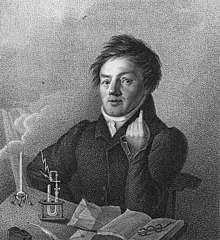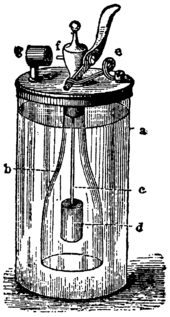Johann Wolfgang Döbereiner
Johann Wolfgang Döbereiner (13 December 1780 – 24 March 1849) was a German chemist who is best known for work that foreshadowed the periodic law for the chemical elements, and for inventing the first lighter, which was known as the Döbereiner's lamp.[1] He became a professor of chemistry and pharmacy at the University of Jena.
Johann Wolfgang Döbereiner | |
|---|---|
 Johann Wolfgang Döbereiner | |
| Born | 13 December 1780 |
| Died | 24 March 1849 (aged 68) Jena, Grand Duchy of Saxe-Weimar-Eisenach |
| Nationality | German |
| Known for | Döbereiner's triads Döbereiner's lamp |
| Scientific career | |
| Fields | Chemistry |
| Institutions | University of Jena |
Life and work
As a coachman's son, Döbereiner had little opportunity for formal schooling. Thus, he was apprenticed to an apothecary, and began to read widely and to attend science lectures. He eventually became a professor at the University of Jena in 1810 and also studied chemistry at Strasbourg. In work published in 1829,[2] Döbereiner reported trends in certain properties of selected groups of elements. For example, the average of the atomic masses of lithium and potassium was close to the atomic mass of sodium. A similar pattern was found with calcium, strontium, and barium; with sulfur, selenium, tellurium; and with chlorine, bromine, and iodine. Moreover, the densities for some of these triads followed a similar pattern. These sets of elements became known as "Döbereiner's triads".[3][4]

Döbereiner also is known for his discovery of furfural,[5] for his work on the use of platinum as a catalyst, and for a lighter, known as Döbereiner's lamp. By 1828 hundreds of thousands of these lighters had been mass produced by the German manufacturer Gottfried Piegler in Schleiz.[6]
The German writer Goethe was a friend of Döbereiner, attended his lectures weekly, and used his theories of chemical affinities as a basis for his famous 1809 novella Elective Affinities.
Works
- Deutsches Apothekerbuch . Vol. 1-3 . Balz, Stuttgart 1842-1848 Digital edition by the University and State Library Düsseldorf
References
- "Treasures: Table lighters ignite interest in collectors". Irish Independent News. 2016-11-11. Retrieved 2017-01-27.
- Döbereiner, Johann Wolfgang (1829). "An Attempt to Group Elementary Substances according to Their Analogies". Annalen der Physik und Chemie. 15 (2): 301–307. Bibcode:1829AnP....91..301D. doi:10.1002/andp.18290910217.
an attempt which I made twelve years ago to group substances by their analogies.
- "Johann Wolfgang Dobereiner". Chemed Chemistry. Archived from the original on 2016-03-23. Retrieved 2016-03-23.
- "A Historic Overview: Mendeleev and the Periodic Table" (PDF). Genesis Mission. NASA. Retrieved 2008-03-08.
- J. W. Döbereiner (1832). "Ueber die medicinische und chemische Anwendung und die vortheilhafte Darstellung der Ameisensäure". Berichte der Deutschen Chemischen Gesellschaft. 3 (2): 141–146. doi:10.1002/jlac.18320030206.
- Thomas, John Meurig (2017). "The RSC Faraday prize lecture of 1989". Chemical Communications. 53 (66): 9185–9197. doi:10.1039/C7CC90240A. PMID 28782762.
Further reading
| Wikisource has the text of a 1911 Encyclopædia Britannica article about Johann Wolfgang Döbereiner. |
- Collins, P. M. D. (1986). "The Pivotal Role of Platinum in the Discovery of Catalysis" (PDF). Platinum Metals Review. 30 (3): 141–146.
- Döbereiner, Johann Wolfgang (1829). "An Attempt to Group Elementary Substances according to Their Analogies". Annalen der Physik und Chemie. 15 (2): 301–307. Bibcode:1829AnP....91..301D. doi:10.1002/andp.18290910217.ff
- Hoffmann, Roald (Jul–Aug 1998). "Döbereiner's Lighter". American Scientist. 86 (4): 326. doi:10.1511/1998.4.326.
- Hoffmann, Roald (1998). "Döbereiner's Lighter". American Scientist. 86 (4): 326. doi:10.1511/1998.4.326. Archived from the original on March 24, 2006.
- Kauffman, George B. (1999). "Johann Wolfgang Döbereiner's Feuerzeug". Platinum Metals Review. 43 (3).
- Kaufmann, George (1999). "From Triads to Catalysis: Johann Wolfgang Döbereiner (1780–1849) on the 150th Anniversary of His Death". The Chemical Educator. 4 (5): 186–197. doi:10.1007/s00897990326a.
- McDonald, Donald (1965). "Johann Wolfgang Döbereiner" (PDF). Platinum Metals Review. 9 (4): 136–139.
- Prandtl, Wilhelm (1950). "Johann Wolfgang Dobereiner, Goethe's Chemical Adviser". Journal of Chemical Education. 27 (4): 176–181. Bibcode:1950JChEd..27..176P. doi:10.1021/ed027p176.
- Kimberley A. McGrath, Bridget Travers. 1999. World of Scientific Discovery. Gale Research.